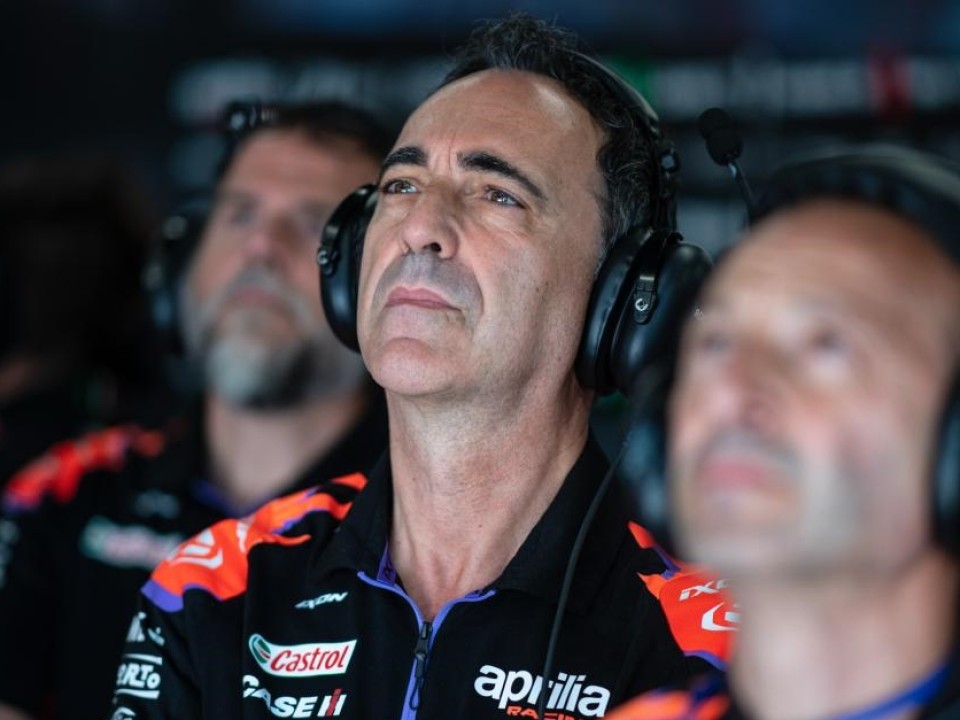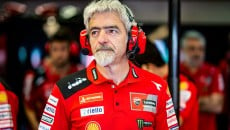It was the changeable weather experienced this weekend in Jerez that put an end to the great moment experienced by the Aprilia Racing team with Maverick Vinales, upsetting the plans of the Noale manufacturer in no small way. Precisely for this reason, the balance drawn by Romano Albesiano, technical director of Aprilia Racing, in the aftermath of the Spanish GP cannot be entirely positive.
"I'm satisfied with the performance in general, but we need to be able to better manage variable situations, such as those found here, where we ruined the weekend in qualifying - he explained - Had it been an all dry or wet weekend, we probably would have fought for the podium, and maybe we would have even got on it. So, the performance itself in my opinion is very good, however, we need to find consistency."
Despite a bit of bitterness in his mouth, the Veneto manufacturer is ready to turn the page, throwing itself headlong into this intense Monday of testing at the Andalusian track.
"In general,the test is divided into two parts. One is refinement, based on the results of the first four races, because sometimes a few small changes can have a big effect. And then there is medium- to long-term development, which covers all parts of the bike apart from the engine: chassis, electronics, transmission, aerodynamics, and of course also the starting devices, which are a key element of performance ," Albesiano said, explaining the day's program. "All the elements have been divided among our five riders. Today Raul is also using the RS-GP 2024, while he usually has last year's."
Crucial for Aprilia, also in light of the demands of its riders, is to work as much as possible on the start phase.
"Speaking in terms of work, we are investing a lot on the start, while the rest is equally distributed between engine, transmission and aerodynamics. Also because the start is the area where there is the most room to gain. Aleix has already tried a few updates, but as he also said it will take a while before we can adopt the solutions in the race, because there is still development to be done, not so much in the starting phase but in the riding conditions," said the engineer. "What the riders are asking is to do better than the others. So when the qualifications are not going great, as unfortunately happened here, they would like to be able to catch up. Everyone is pushing so hard though, so even though we are improving and have incredible start times, everyone has them and they are doing an incredible job. It's hard, because you have to push and keep progressing to get to the same level where the others are. Not counting KTM, which is maybe a step ahead, I would say we are at a good level, but not to a point where we are making up four positions at the start. We are working on it."
Although the Austrian manufacturer remains one step ahead of its rivals at the start, at this start of the championship it is Aprilia that seems to be emerging as a rival to Ducati.
"I don't know, these rankings are made by journalists, we don't make them. I just say that last year, and again this year, Aprilia won races, KTM did not. So I don't know if KTM is the first rival of Ducati," commented the technical director of the Noale manufacturer, who regarding the progress made by Vinales added: "For Maverick it is fundamental to find the balance between the way the front tire works and the way the rear tire works in order to have neither understeer nor oversteer. And his riding position was a move to obttain this, but it's only part of the story."
Although the new technical regulations for 2027 have not yet been issued, it is already expected that such a big change will have major repercussions on development for the next two seasons.
"Resources will clearly have to be diverted. It will be up to each team to decide how much to keep on the 1,000 cc. However, these are aspects we are discussing. Obviously, for the new bike you will have to start from a blank sheet of paper, so it is a huge commitment for the manufacturers, because you have to keep spending for the season, with some development attached, while you build another bike. It's really a big commitment for the manufacturers ," Albesiano noted, giving an idea of what the timeline for the development of the new MotoGP bikes might be: "Although it's been a short time, we have already started working on it. The first part that you do is the engine, which has to be born already inside the layout of the bike anyway, because if the engine is born before the bike itself you're going to screw up. I think each team will try to start running with the new prototype in the spring of 2026, if not before. And then we will see."









